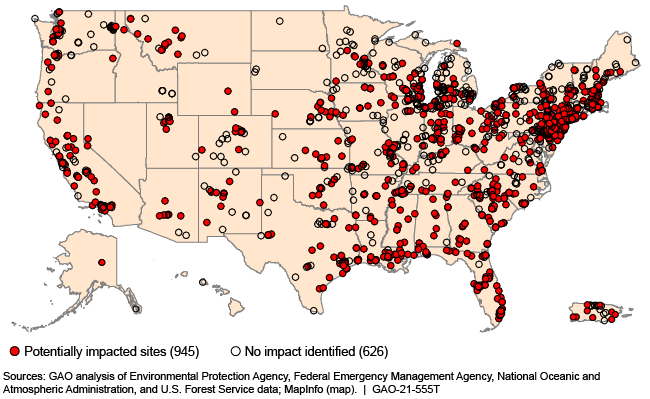Superfund: EPA Should Take Additional Actions to Manage Risks from Climate Change Effects
Fast Facts
Climate change may increase the frequency and intensity of certain natural disasters, which could damage Superfund sites—the nation's most contaminated hazardous waste sites.
Federal data suggests about 60 percent of Superfund sites overseen by EPA are in areas that may be impacted by wildfires and different types of flooding—natural hazards that may be exacerbated by climate change.
We testified that EPA has taken some actions to manage risks at these sites. Also, EPA should provide direction on integrating climate information into site-level decision making to ensure long-term protection of human health and the environment.
Superfund Sites Located in Areas that May Be Impacted by Flooding, Storm Surge, Wildfires, or Sea Level Rise

Highlights
What GAO Found
In October 2019, GAO reported that available federal data on flooding, storm surge, wildfires, and sea level rise suggested that about 60 percent (945 of 1,571) of all nonfederal Superfund National Priorities List (NPL) sites—which have serious hazardous contamination--are located in areas that may be impacted by these potential climate change effects (see figure). In 2019, GAO released an interactive map and dataset, available with its report (GAO-20-73).
Nonfederal NPL Sites Located in Areas That May Be Impacted by Flooding, Storm Surge, Wildfires, or Sea Level Rise, as of 2019

Notes: This map does not display all 1,571 active and deleted nonfederal NPL sites GAO analyzed in 2019, which also include six sites in American Samoa, the Federated States of Micronesia, Guam, the Northern Mariana Islands, and the U.S. Virgin Islands, though they are included in the counts above. Learn more at https://www.gao.gov/products/GAO-20-73. Storm surge data were not available for the West Coast and Pacific islands other than Hawaii, wildfire data were not available outside the contiguous United States, and sea level rise data were not available for Alaska.
GAO also reported in 2019 that the Environmental Protection Agency's (EPA) actions to manage risks from climate change effects at these sites aligned with three of GAO's six essential elements of enterprise risk management, partially aligned with two, and did not align with one. For example, EPA had not aligned its process for managing risks with agency-wide goals. Without clarifying this linkage, EPA could not ensure that senior officials would take an active role in strategic planning and accountability for managing these risks.
In 2019, GAO found that EPA recognized institutional, resource, and technical challenges in managing risks from climate change effects. For example, some EPA officials told us they do not have the direction they need to manage these risks. Insufficient or changing resources may also make it challenging for EPA to manage these risks, according to EPA documents and officials.
Why GAO Did This Study
Superfund is the principal federal program for addressing sites contaminated with hazardous substances. EPA administers the program and lists some of the most seriously contaminated sites—most of which are nonfederal—on the NPL. At those sites, EPA has recorded over 500 contaminants, including arsenic and lead. Climate change may make some natural disasters more frequent or more intense, which may damage NPL sites and potentially release contaminants, according to the Fourth National Climate Assessment.
This testimony summarizes GAO's October 2019 report (GAO-20-73) on the impact of climate change on nonfederal NPL sites. Specifically, it discusses (1) what available federal data suggest about the number of nonfederal NPL sites that are located in areas that may be impacted by selected climate change effects; (2) the extent to which EPA has managed risks to human health and the environment from the potential impacts of climate change effects at nonfederal NPL sites; and (3) challenges EPA faces in managing these risks.
Recommendations
In the report on which this testimony is based, GAO made four recommendations to EPA, including that it more closely align its actions with GAO's essential elements of enterprise risk management. EPA originally agreed with one recommendation and disagreed with the others, but is taking steps to respond to three of the recommendations and is considering action on the other. GAO continues to believe action on all four is warranted.
